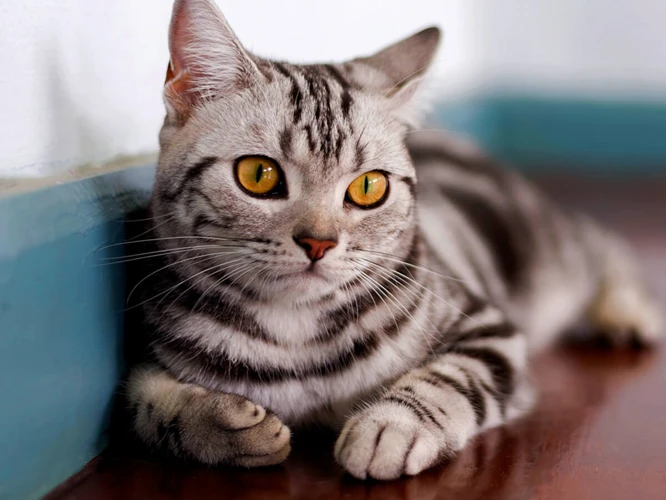Picture yourself coming home after a long day, ready to unwind and relax. As soon as you open the door, your beloved American Shorthair cat greets you with a meow and a rub against your legs. But as you take a step forward, they suddenly dart away and hiss at something in the distance. You notice that your cat seems to be guarding a particular area in the house, even though they’ve never shown this behavior before. You start wondering: what is causing this sudden territorial behavior, and what can you do to help your feline friend feel more at ease? Understanding the factors that influence territorial behavior in American Shorthairs is the first step towards creating a happy and harmonious home for both you and your furry companion.
The Instinct to Stake a Claim

As cat owners, we’ve all witnessed our American Shorthairs marking their territory, whether it’s rubbing their paws against a piece of furniture or arching their backs and puffing up their fur. This territorial behavior is innate in our furry friends and serves as a way for them to claim their space and assert their dominance. However, this instinct to stake a claim goes much deeper than just a show of power. Understanding the factors that influence territorial behavior in American Shorthairs can help you better manage your pet’s instincts and create a harmonious living space for all. Let’s dig deeper into the evolutionary roots and hormonal influence behind this behavior.
Their Evolutionary Roots
American Shorthairs’ territorial behavior comes from their evolutionary roots as predators. Their natural instinct to hunt and defend their prey and territory has allowed them to survive and thrive in their environment. This behavior is inherited from their ancestors, who had to compete for food and living space to ensure their survival.
Their hunting instincts are still present in domestic American Shorthairs, causing them to mark their territory and protect their resources. This is why providing a safe and secure environment for your cat is crucial. You can do this by making sure they have access to a high place to climb, like a tree or a cat tower, and ensuring that their litter box and food and water bowls are not in a high-traffic area where they may feel threatened.
American Shorthairs have a natural inclination towards routine and stability, developed over generations of surviving in the wild. Disrupting their routines or changing their environment suddenly can cause stress, leading to aggressive behavior or other negative consequences.
To mitigate this behavior, it’s important to provide ample opportunities for stimulation and exercise, and to encourage calm and predictable routines. A consistent routine can help your cat feel secure and comfortable in their environment. For more tips on managing territorial behavior, check out our article on cat stress management tips.
The Role of Hormones
The Role of Hormones
Hormonal changes play a significant role in the territorial behavior of American Shorthairs. Testosterone, for instance, plays a crucial role in marking behavior. Un-neutered males produce a specific type of urine containing high levels of testosterone to mark their territory. This type of urine is different from that produced by female American Shorthairs and neutered males.
On the other hand, estrogen affects the sensitivity of female American Shorthairs to pheromones, the scent marks left by other cats. Female cats with high levels of estrogen, especially during their estrus cycle, exhibit intense territorial behavior and aggression towards other cats.
It is essential to address hormonal imbalances in cats to control territorial behavior. Spaying and neutering American Shorthairs is an effective way to reduce hormonal influence and control their urge to mark their territory or engage in aggressive behavior.
Providing adequate environmental enrichment and positive reinforcement training can also help manage the effects of hormones on territorial behavior. By ensuring that cats have plenty of mental and physical stimulation, you can help reduce their territorial marking behavior and minimize aggression towards other cats.
| Hormones | Effect on Territorial Behavior |
|---|---|
| Testosterone | High levels in un-neutered males result in marking behavior to claim territory |
| Estrogen | High levels in females increase sensitivity to pheromones and may cause territorial aggression towards other cats |
Managing hormonal impacts on territorial behavior is critical in promoting safety and well-being in American Shorthairs. By taking the necessary steps, cat owners can ensure a happy and healthy environment for their pets and prevent aggressive or destructive behavior that could harm both pets and owners.
The Influence of Environment

As creatures inherently linked to their surroundings, the environment an American Shorthair cat inhabits plays a significant role in shaping their behaviors, including territorial behavior. Indoor vs outdoor living, the size of a space they occupy, and the degree of confinement, all determine how territorial your feline friend can be. Understanding how these factors impact your cat’s behavior is essential to ensure they are comfortable and content in their living situation. Additionally, it can help you proactively create a cat-friendly home that caters to your kitty’s natural instincts.
Indoor vs Outdoor
When it comes to understanding your American Shorthair’s territorial behavior, one important factor to consider is whether they are an indoor or outdoor cat. While indoor cats have a smaller territory to defend, outdoor cats have a larger area to patrol and protect.
Indoor cats tend to have a more limited area to call their own. However, this doesn’t mean that they don’t display territorial behavior. It is common for indoor cats to mark their territory by scratching furniture or spraying urine in areas they frequent. Indoor cats may also display territorial aggression towards other pets or even humans that they perceive as threatening their space. One way to combat this behavior is to provide your indoor cat with ample scratching posts and toys to redirect their behavior.
Outdoor cats, on the other hand, have a larger territory to defend. They may feel the need to mark and defend this territory by spraying urine, scratching trees, or vocalizing. Additionally, outdoor cats may display aggression towards other cats or animals that they view as a threat to their territory. It’s important to monitor your outdoor cat’s behavior and make sure they are not getting into fights or putting themselves in danger by climbing trees or structures that may not be safe.
To ensure the safety of your American Shorthair, it may be best to keep them indoors. However, if you do choose to let your cat outside, be sure to provide them with safe climbing options and supervise them when they are exploring new areas.
For more information on understanding your American Shorthair’s behavior, consider checking out our article on positive reinforcement or our article on body language.
Size of Territory
Size of Territory
Another factor that influences territorial behavior in American Shorthairs is the size of their territory. Like all cats, American Shorthairs have a natural instinct to roam and explore their environment. The size of the territory they claim as their own can have a significant impact on their behavior.
American Shorthairs who have access to larger territories tend to exhibit less territorial behavior and aggression. They have more space to roam and hunt, and are less likely to feel threatened by other cats or animals. This can also contribute to their overall health and well-being, as they have more opportunities for exercise and stimulation.
On the other hand, American Shorthairs who are confined to smaller spaces may exhibit more territorial behavior. They may become defensive and aggressive to protect what little space they have. This can be especially true for indoor cats who do not have access to outdoor space, as they may feel the need to defend the limited territory they have.
It’s important for cat owners to understand the role that territory plays in their American Shorthair’s behavior, and to provide them with adequate space. This may mean allowing your cat access to outdoor space, or creating an indoor environment that provides plenty of room for them to roam and play.
Size of Territory: Comparison Table
To give you a better understanding of how territory size impacts American Shorthair behavior, we’ve put together a comparison table:
| Size of Territory | Behavioral Impact |
|---|---|
| Small | Increased territorial behavior and aggression |
| Large | Decreased territorial behavior and aggression, increased exercise and stimulation |
As you can see, the size of your American Shorthair’s territory can have a significant impact on their behavior and well-being. It’s important to provide them with adequate space and stimulation to keep them happy and healthy. If you have a confined space for your cat, consider ways to create a cat climbing safety mechanism. This can give your cat more vertical space, which is important for their physical and mental health.
Confinement
Cats are natural explorers, so it can be quite challenging for a cat to be confined in a small space. Confinement, whether temporary or permanent, can have a significant impact on your American Shorthair’s behavior. For example, when you confine your cat to a small space for an extended period, this can trigger stress, anxiety, and frustration. When a cat cannot release its energy, it can lead to vocalizations or destructive behaviors.
Confinement can also lead to territorial behavior. When your cat feels confined, they may become protective and possessive of their environment, leading to aggression towards humans and other animals in the household.
When you have to confine your American Shorthair for any reason, it is important to provide them with the necessary space and amenities that match their natural tendencies. An enclosed space where they can climb and jump will help your cat satisfy its natural desire for exploring and playtime.
You can provide your cat with a variety of toys, puzzles, and scratching posts designed to keep them mentally stimulated while you are away. Also, ensure that your cat has access to a clean litter box, fresh water, and a comfortable place to rest.
Confinement can be difficult for your American Shorthair, leading to stress, anxiety, aggression, and territorial behavior. By providing your cat with ample space, stimulation, and amenities during confinement, you can help them feel secure and comfortable, reducing the likelihood of adverse behavior.
Social Factors

One important aspect of understanding a cat’s territorial behavior is considering the role of social factors. Cats are social animals, and their relationships with other cats and humans can greatly influence their behavior. While some cats may be more solitary, most American Shorthairs thrive on social interaction. It’s important for cat owners to not only understand their cat’s individual personality but also the impact that social factors can have on their behavior. From interactions with other cats to bonding with their humans, social dynamics play a crucial role in shaping a cat’s behavior. If you’re interested in learning more about how social factors can impact an American Shorthair’s behavior, be sure to check out our article on introducing American Shorthairs to new pets.
Relationships with Other Cats
When it comes to American Shorthairs, their relationships with other cats can greatly influence their territorial behaviors. Introducing a new cat into the household can be a difficult task, as the resident cat may feel threatened and become aggressive towards the newcomer. This can cause territorial marking, scratching, and even physical fights between the two cats.
One way to address this issue is to ensure that the resident cat has a safe space to retreat to, such as a separate room or a high perch where they can observe the newcomer from a distance. Additionally, making sure that each cat has their own food and water bowls, litter boxes, and toys can help to minimize competition and territoriality.
Gender can also play a role in the dynamics between cats, as male cats are often more territorial than females. This can lead to aggressive behavior towards other male cats, particularly if they are not neutered. Ensuring that all cats in the household are spayed or neutered can help to reduce these territorial behaviors.
It is important to monitor the interactions between cats to ensure that they are safe and not exhibiting any aggressive behavior. If one cat is consistently bullying or attacking the other, it may be necessary to separate them permanently in order to prevent injuries and reduce stress for both cats.
In addition to relationships with other cats, interactions with humans can also impact a cat’s territorial behavior. Providing regular playtime and positive reinforcement can help to reduce stress and promote a sense of security in the cat.
Climbing structures can also provide a sense of security for cats, as they allow them to perch up high and observe their surroundings. This can be particularly important in multi-cat households, where there may be competition for resources and a need for personal space.
Understanding the social factors that influence a cat’s territorial behavior can help owners to create a safe and harmonious environment for their American Shorthair and any other feline companions in the home.
Interaction with Humans
Cats are known for their independence, but they are not solitary animals. American Shorthairs are no exception and crave interaction with humans. Positive interaction with their owners can help immensely in managing their territorial behavior.
However, negative interactions such as harsh discipline or aggression towards the cat can worsen the problem. Cats need to feel safe and comfortable in their environment to be able to manage their territorial behavior (Aggressive Behavior in American Shorthairs).
Playing with your American Shorthair is one way to positively interact with them. It stimulates their minds and bodies and creates a bond between you and your furry companion (American Shorthair Kitten Development and Behavioral Care). Engaging in gentle play can help your cat feel more secure in their environment and reduce their territorial behavior.
Giving your cat a safe space where they feel protected is essential. Interrupting their alone time can cause stress and anxiety, and make them feel threatened. This interferes with their territory, which triggers territorial behavior. By providing them a personal space (American Shorthair Litter Preferences), they feel safe in their environment decreasing territorial behavior.
Lastly, cats are known to be creatures of habit. Consistency is key when it comes to their interaction with humans. Make sure they receive enough attention, and they feel loved all the time. This also means that you should keep a consistent schedule for feeding, playtime, grooming, and any other interaction with your cat to make their routine and daily life comfortable.
Positive interaction is the backbone of managing territorial behavior in American Shorthairs. By giving your furry companion enough attention and providing them with a safe space, you can manage their territorial behavior while creating a bond between you and your furry friend.
Signs of Territorial Behavior

Understanding your cat’s territorial behavior is essential for maintaining a healthy and happy cat-parent relationship. If you notice certain behaviors, it is likely that your furry friend is staking their claim to their territory. The most common signs of territorial behavior in American Shorthairs are aggression, spraying, scratching, and vocalization.
Aggression: Aggression towards other cats or humans is a clear indication of territorial behavior. This could include hissing, growling, or biting when someone or something enters their perceived territory.
Spraying: Spraying is another sign of territorial behavior in American Shorthairs. They release urine on vertical surfaces, such as walls or furniture, to leave their scent and mark their territory.
Scratching: Scratching is a natural behavior of cats, but when it becomes excessive, it could be a sign of territorial behavior. The cat may scratch furniture, walls, or carpet to mark their territory and claim their space.
Vocalization: Vocalization is another way for cats to communicate their territorial boundaries. American Shorthairs may vocalize loudly or persistently to warn others that they are encroaching on their territory.
If you notice any of these signs in your cat, it’s important to take action to prevent territorial behavior from becoming a problem.
Internal link: For more information on American Shorthair cats, read our article on the gender impact on American Shorthairs.
Addressing Territorial Behaviors
As a cat owner, it can be concerning when your American Shorthair exhibits territorial behavior. However, there are steps you can take to address this behavior and create a peaceful living environment for both you and your furry friend. By understanding the root of territorial behavior and implementing strategies to address it, you can create a safe and enjoyable home for your beloved pet. Let’s dive into some practical ways in which you can address territorial behaviors in your American Shorthair.
Creating a Safe Space
Cats rely on having their own space where they feel safe and secure. When addressing territorial behaviors, one effective strategy is creating a safe space for your cat. This is an area that your cat associates with positive experiences and personal comfort. Below are some ideas for creating a safe space for your feline friend:
- Provide a cozy bed: Give your cat a warm, comfortable bed where they can curl up and relax. Make sure the bed is in a quiet, low-traffic area where your cat won’t be disturbed.
- Add familiar scents: Your cat’s safe space should have their own scent. You can achieve this by adding blankets or bedding that have your cat’s scent on them. This will provide a familiar scent that can help your cat feel more at ease.
- Use pheromones: Feline pheromone products can help calm a nervous cat. You can find sprays, diffusers, and collars that release artificial pheromones that mimic the natural pheromones cats use to communicate.
- Offer hiding places: Cats like to have a place to retreat to when they feel threatened or anxious. Provide a cozy cat condo, a covered cat bed, or a cardboard box with a hole cut on the side. These hiding places can also function as their own territory.
- Keep food and water nearby: Make sure your cat’s safe space has access to fresh water and food. This will allow your cat to feel comfortable and relaxed while they eat and drink.
By creating a safe space for your cat, you’re giving them a space where they can feel in control and relaxed. This will help reduce territorial behaviors and make your cat feel more comfortable in their environment.
Providing Stimulation
Cats are natural hunters and require mental and physical stimulation to maintain their mental health. According to experts, providing stimulation is one of the best ways to manage territorial behavior in American Shorthairs. Here are some ways to provide stimulation to your feline friend:
- Provide Interactive Toys: Interactive toys are a great way to stimulate your cat’s mind and keep them active. Toys such as wand toys, baffles, and puzzle feeders keep your cat engaged and active for a long time. These toys mimic hunting and foraging behavior, allowing your cat to satisfy their natural instincts. Just make sure to rotate toys frequently to prevent boredom and reduce familiarization.
- Offer Scratching Posts: Scratching is a natural behavior in cats and is essential for their physical and mental wellness. Scratching posts provide an outlet for your cat’s natural scratching behavior and also helps keep their claws healthy. This helps to reduce territorial behavior related to their desire to mark their area with their scent. Make sure to place the posts in areas where your cat is already scratching to encourage them to use it more frequently.
- Play Regularly: Playtime is essential for keeping your cats mentally and physically happy. Taking time to play with your cat regularly is a fantastic way to keep them stimulated and happy. Try using toys such as feathers, balls, and lasers to engage them in play. However, never use your hands as a toy since cats can easily confuse them for prey, leading to accidental scratching.
- Use Cat Trees: Cat trees are excellent for providing a high space for cats to perch and relax. They can also use cat trees to scratch and climb providing additional opportunity for physical and mental stimulation. If you have more than one cat at home, provide sufficient cat trees and other resources to avoid competition and territorial behaviors.
Incorporating these activities into your daily routine will help provide a stimulating environment, reduce the intensity of territorial behaviors, and lead to a happier, healthier cat.
Creating Boundaries
As mentioned earlier, creating boundaries is crucial when dealing with territorial behavior in American Shorthairs. One way to do this is to provide them with their own space. You can achieve this by setting up areas that are designated for your cat’s use only. Below are some tips on how to create boundaries for your feline friend:
| Tip 1 | Tip 2 | Tip 3 |
|---|---|---|
| Use cat trees or shelves that are at different heights to create vertical space for your cat. | Place a scratching post or pad in their designated area to encourage them to scratch in the appropriate place. | Use baby gates or barriers to block off areas of your home that your cat should not have access to. |
| Provide your cat with a bed or cozy spot to relax within their designated area. | Place their food and water bowls in their designated area to clearly define their territory. | Use pheromone sprays or diffusers to create a calming atmosphere within their designated area. |
By creating boundaries, your cat can have their own space and feel comfortable in their environment. This can also help prevent aggressive behavior towards other pets or humans who come into their designated area. Remember to always give your cat positive reinforcement when they use their designated area and avoid punishing them for territorial behavior outside of it.
Conclusion
After considering the various factors that influence territorial behavior in American Shorthairs, it becomes apparent that understanding your cat’s instincts is crucial to maintaining a harmonious environment. As a pet owner, it is essential to recognize that territorial behavior is innate and has evolutionary roots. Taking a proactive approach to address territorial behavior in American Shorthairs will not only improve their quality of life but also yours.
The role of hormones cannot be overstated, and sterilization should be considered to prevent aggressive and territorial behavior in unneutered or unspayed cats. Additionally, the environmental factors – indoor vs outdoor living, the size of the territory, and the degree of confinement, all play significant roles in determining if your cat will exhibit territorial behavior.
Social factors also contribute to American Shorthairs’ territorial behavior, particularly the relationships that they have with other cats and humans. Proper socialization and interaction early in life can help prevent territorial behavior from developing.
Recognizing the signs of territorial behavior, such as inappropriate urination or aggression, is crucial for optimal feline health and well-being. Addressing territorial behaviors requires creating a safe space for your cat, providing stimulation such as toys and playtime, and establishing boundaries that guide her behavior.
In conclusion, understanding the many factors that influence territorial behavior in American Shorthairs is crucial to creating a peaceful coexistence between you and your feline companion. By addressing territorial behavior proactively, pet owners can ensure a happier, healthier life for their beloved furry friends.
Frequently Asked Questions
What are American Shorthair cats?
American Shorthair cats are a breed originating from America that are known for their affectionate and playful personalities. They have short, dense coats and can come in a variety of colors and patterns.
Why do cats exhibit territorial behavior?
Cats exhibit territorial behavior as a way to establish dominance and protect their resources such as food, water, and shelter.
Do hormones play a role in territorial behavior?
Yes, hormones play a role in territorial behavior. Male cats tend to exhibit more territorial behavior due to their higher levels of testosterone.
Is it better for cats to live indoors or outdoors?
It is generally recommended for cats to live indoors as it provides a safer environment and helps prevent territorial conflicts with other cats.
Can confinement affect a cat’s territorial behavior?
Yes, confinement can affect a cat’s territorial behavior as it can cause them to feel stressed and anxious, leading to more aggressive behavior.
Can a cat’s relationship with humans affect their territorial behavior?
Yes, a cat’s relationship with humans can affect their territorial behavior. A cat who feels safe and secure in their home with their human companion is less likely to exhibit aggressive territorial behavior.
What are some signs of territorial behavior in cats?
Some signs of territorial behavior in cats include spraying or marking their territory with urine, aggressive behavior towards other cats or humans, and guarding areas within the home.
How can I address my cat’s territorial behavior?
You can address your cat’s territorial behavior by creating a safe and comfortable space for them, providing plenty of stimulation and playtime, and setting clear boundaries within the home.
What is the best way to introduce a new cat into the home?
The best way to introduce a new cat into the home is to do so gradually, giving both cats time to adjust and get to know each other’s scents before any physical interaction takes place.
Can spaying or neutering cats help prevent territorial behavior?
Yes, spaying or neutering cats can help prevent territorial behavior as it can reduce their levels of testosterone and decrease their desire to mark their territory.







